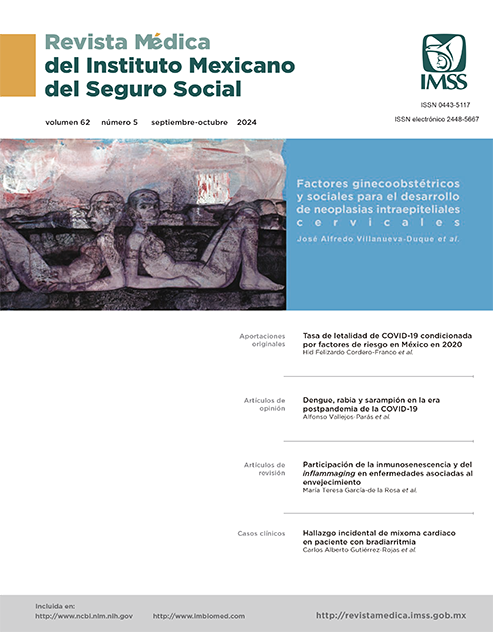Demencia rápidamente progresiva por neurosífilis tardía (paresia general). Reporte de un caso
##plugins.themes.themeEleven.article.main##
Palabras clave
Demencia, Neurosífilis, Treponema pallidum, Paresia, Sífilis / Dementia, Neurosyphilis, Paresis, Syphilis
Resumen
Introducción: el término demencia rápidamente progresiva (DRP) describe un trastorno con progresión rápida que conduce a un deterioro cognitivo mayor en un lapso de menos de 1 o 2 años. La neurosífilis es una causa infecciosa de DRP y se clasifica clínicamente en formas tempranas y tardías. Las tardías afectan al cerebro y al parénquima de la médula espinal. El objetivo de este reporte es presentar un caso de DRP causada por neurosífilis.
Caso clínico: hombre de 55 años, sin antecedentes de importancia, que presentó cuadro iniciado en julio de 2022 con agresividad, irritabilidad, labilidad, dificultad para realizar actividades sencillas, amnesia, alucinaciones, delusiones, abulia, pobre reactividad al medio, todo lo cual afectó su independencia y calidad de vida. Fue manejado de inicio como esquizofrenia sin mejoría y con empeoramiento clínico. Al observar en consulta en enero de 2023 datos atípicos y velocidad de progresión, se abordó al paciente para DRP y destacó el VDRL (Venereal Disease Research Laboratory) positivo, con anticuerpos IgM e IgG anti Treponema pallidum en líquido cefalorraquídeo (LCR) positivos. La tomografía axial computarizada (TAC) y la resonancia magnética (RMN) presentaron atrofia cortical global de predominio frontal. Se inició tratamiento con ceftriaxona por 14 días con mejoría clínica objetivada al practicársele un test de Montreal, MOCA de 13/30 a 23/30.
Conclusiones: la identificación etiológica de DRP es un desafío clínico por la gran variedad de causas, por lo que es importante hacer un abordaje diagnóstico dirigido y tener un tratamiento oportuno con el fin de evitar la progresión de las causas potencialmente reversibles.
Referencias
Hermann P, Zerr I. Rapidly progressive dementias - aetiologies, diagnosis and management. Nat Rev Neurol. 2022;18(6):363–76. doi: 10.1038/s41582-022-00659-0.
Day GS. Rapidly progressive dementia. Continuum (Minneap Minn). 2022;28(3):901-36. doi: 10.1212/CON.0000000000001089.
Chow F. Neurosyphilis. Continuum (Minneap Minn). 2021;27(4):1018-39. doi: 10.1212/CON.0000000000000982.
Ghanem KG, Ram S, Rice PA. The modern epidemic of syphilis. N Engl J Med. 2020;382(9):845-54. doi: 10.1056/NEJMra1901593.
Hamill MM, Ghanem KG, Tuddenham S. State-of-the-Art Review: Neurosyphilis. Clin Infect Dis. 2024;78(5):e57-e68. doi: 10.1093/cid/ciad437.
González-Martínez P, Oltra-Cucarella J, Sitges-Maciá E, et al. Revisión y actualización de los criterios de deterioro cognitivo objetivo y su implicación en el deterioro cognitivo leve y la demencia. Rev Neurol. 2021;72(08):288. doi: 10.33588/rn.7208.2020626.
Liu X, Sun Y, Zhang X, et al. Prevalence and outcomes of rapidly progressive dementia: a retrospective cohort study in a neurologic unit in China. BMC Geriatr. 2023;23(1). doi: 10.1186/s12877-023-03841-1.
Anuja P, Venugopalan V, Darakhshan N, et al. Rapidly progressive dementia: An eight year (2008–2016) retrospective study. PLoS One. 2018;13(1):e0189832. doi: 10.1371/journal.pone.0189832.
Jackson DA, McDonald R, Quilter LAS, et al. Reported neurologic, ocular, and otic manifestations among syphilis cases—16 states, 2019. Sex Transm Dis. 2022;49(10):726-32. doi: 10.1097/olq.0000000000001673.
Day GS. Reversible dementias. Continuum (Minneap Minn). 2019;25(1):234-53. doi: 10.1212/con.0000000000000688.
Ropper AH. Neurosyphilis. N Engl J Med. 2019;381(14):1358-63. doi: 10.1056/nejmra1906228.
Vadboncoeur J, Labbé A-C, Fortin C, et al. Ocular syphilis: case series (2000–2015) from 2 tertiary care centres in Montreal, Canada. Can J Ophthalmol. 2020;55(1):30-7. doi: 10.1016/j.jcjo.2019.05.009.
Workowski KA, Bachmann LH. Centers for Disease Control and Prevention’s sexually transmitted diseases infection guidelines. Clin Infect Dis. 2022;74(Supplement_2):S89-94. doi: 10.1093/cid/ciab1055.
Arando-Lasagabaster M, Otero-Guerra L. Sífilis. Enferm Infecc Microbiol Clin. 2019;37(6):398-404. doi: 10.1016/j.eimc.2018.12.009.
Janier M, Unemo M, Dupin N, et al. 2020 European guideline on the management of syphilis. J Eur Acad Dermatol Venereol. 2021;35(3):574-88. doi: 10.1111/jdv.16946.
Raji CA, Benzinger TLS. The value of neuroimaging in dementia diagnosis. Continuum (Minneap Minn). 2022;28(3):800-21. doi: 10.1212/con.0000000000001133.
Buitrago-Garcia D, Martí-Carvajal AJ, Jimenez A, et al. Antibiotic therapy for adults with neurosyphilis. Cochrane Libr. 2019;2019(5). doi: 10.1002/14651858.cd011399.pub2.
Workowski KA, Bachmann LH, Chan PA, et al. Sexually transmitted infections treatment guidelines, 2021. MMWR Recomm Rep. 2021;70(4):39-46. doi: 10.15585/mmwr.rr7004a.
Dunaway SB, Maxwell CL, Tantalo LC, et al. Neurosyphilis treatment outcomes after intravenous penicillin G versus intramuscular procaine penicillin plus oral probenecid. Clin Infect Dis . 2020;71(2):267-73. doi: 10.1093/cid/ciz795.
Bettuzzi T, Jourdes A, Robineau O, et al. Ceftriaxone compared with benzylpenicillin in the treatment of neurosyphilis in France: a retrospective multicentre study. Lancet Infect Dis. 2021;21(10):1441-7. doi: 10.1016/s1473-3099(20)30857-4f.


